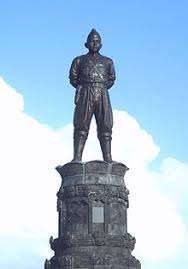Travel : cheaptickets,


At the time of the Dutch troops had successfully landed in Bali, political developments in the center of the Government of the Republic of Indonesia is less favorable due Linggajati negotiations, in which the island of Bali are not recognized as part of the Republic of Indonesia. Balinese people generally feel disappointed about the content of the talks because they felt entitled to enter a part of theRepublic of Indonesia (Republic
of Indonesia Lombok to face opposition and I Gusti Ngurah Rai Bali
People. Besides feeling enraged at the defeat in the first battle, was also
upset that the Dutch troops to the consolidation and concentration of troops
stationed at Ngurah Rai Adeng Village , District Marga, Tabanan, Bali .
After successfully collecting troops from Bali and Lombok, and the Netherlands

The highlight event
On 20 November 1946 I Gusti Ngurah Rai and his troops (Ciung Vanara), do longmarch to Mount Agung, the eastern tip of the island of Bali. But suddenly in the middle of the journey, these troops intercepted by Dutch soldiers in thevillage of Marga ,
Tabanan, Bali .
Inevitably, a fierce battle was not heeded. So torn areas Marga which was then surrounded by a quiet cornfield, turned into a tumultuous and thrilling battle for the residents. The sound of guns suddenly burst simultaneously cornfields surrounded the hilly area, located about 40 kilometers from Denpasar.
Vanara troops Ciung youth who was still not ready with the weapons, not too hasty to attack the Dutch soldiers. They are still focusing its defense and wait for the command of I Gusti Ngoerah Rai to avenge the attack. Once fired shots attack signs, dozens of young men burst out of the cornfield and reply to ambush soldiers Indies Civil Administration (NICA) formed by the Dutch. With arms loot, eventually repelled Ciung Vanara Dutch soldiers.

But apparently the battle is not over. This time the Dutch soldiers who had provoked emotions turn into increasingly brutal. This time, not only burst weapon sounds, but the young troops stormed NICA Ngoerah I Gusti Rai by bombs from aircraft. Paddy fields and lush cornfields now become killing fields full of smoke and blood.
War or blowing it up is then ended the life I Gusti Ngurah Rai. The event is then recorded as Puputan Margarana. That evening on 20 November 1946 at Marga is an important milestone in the history of people's struggle against the colonial Dutch inIndones ia for Nusa and the Nation.

Computers & Electronics : JOBY, butterflyphoto.com, kata-bags , canvasondemand, electronicexpress
Computers & Electronics : JOBY, butterflyphoto.com, kata-bags , canvasondemand, electronicexpress |
Background The
advent of blowing itself begins talks Margarana Linggarjati. On 10 November
1946, the Dutch Linggarjati talks with the Indonesian government. One of the
contents of the negotiations Linggajati is the Dutch recognized the de facto
jurisdiction of the Republic of Indonesia with covering Sumatra ,
Java, and Madura. Furthermore, the Netherlands Bali ,
followed by figures in favor of the Dutch. The purpose of landing the Netherlands to Bali
itself is to enforce the establishment of the State of East Indonesia. At that
time Lieutenant Colonel I Gusti Ngurah Rai, who served as Commander orderly
Lombok to Yogyakarta was going to hold
consultations with the Supreme Headquarters TRI, so he did not know about the
Dutch landing.
At the time of the Dutch troops had successfully landed in Bali, political developments in the center of the Government of the Republic of Indonesia is less favorable due Linggajati negotiations, in which the island of Bali are not recognized as part of the Republic of Indonesia. Balinese people generally feel disappointed about the content of the talks because they felt entitled to enter a part of the
The highlight event
On 20 November 1946 I Gusti Ngurah Rai and his troops (Ciung Vanara), do longmarch to Mount Agung, the eastern tip of the island of Bali. But suddenly in the middle of the journey, these troops intercepted by Dutch soldiers in the
Inevitably, a fierce battle was not heeded. So torn areas Marga which was then surrounded by a quiet cornfield, turned into a tumultuous and thrilling battle for the residents. The sound of guns suddenly burst simultaneously cornfields surrounded the hilly area, located about 40 kilometers from Denpasar.
Vanara troops Ciung youth who was still not ready with the weapons, not too hasty to attack the Dutch soldiers. They are still focusing its defense and wait for the command of I Gusti Ngoerah Rai to avenge the attack. Once fired shots attack signs, dozens of young men burst out of the cornfield and reply to ambush soldiers Indies Civil Administration (NICA) formed by the Dutch. With arms loot, eventually repelled Ciung Vanara Dutch soldiers.
But apparently the battle is not over. This time the Dutch soldiers who had provoked emotions turn into increasingly brutal. This time, not only burst weapon sounds, but the young troops stormed NICA Ngoerah I Gusti Rai by bombs from aircraft. Paddy fields and lush cornfields now become killing fields full of smoke and blood.
War or blowing it up is then ended the life I Gusti Ngurah Rai. The event is then recorded as Puputan Margarana. That evening on 20 November 1946 at Marga is an important milestone in the history of people's struggle against the colonial Dutch in
Comments